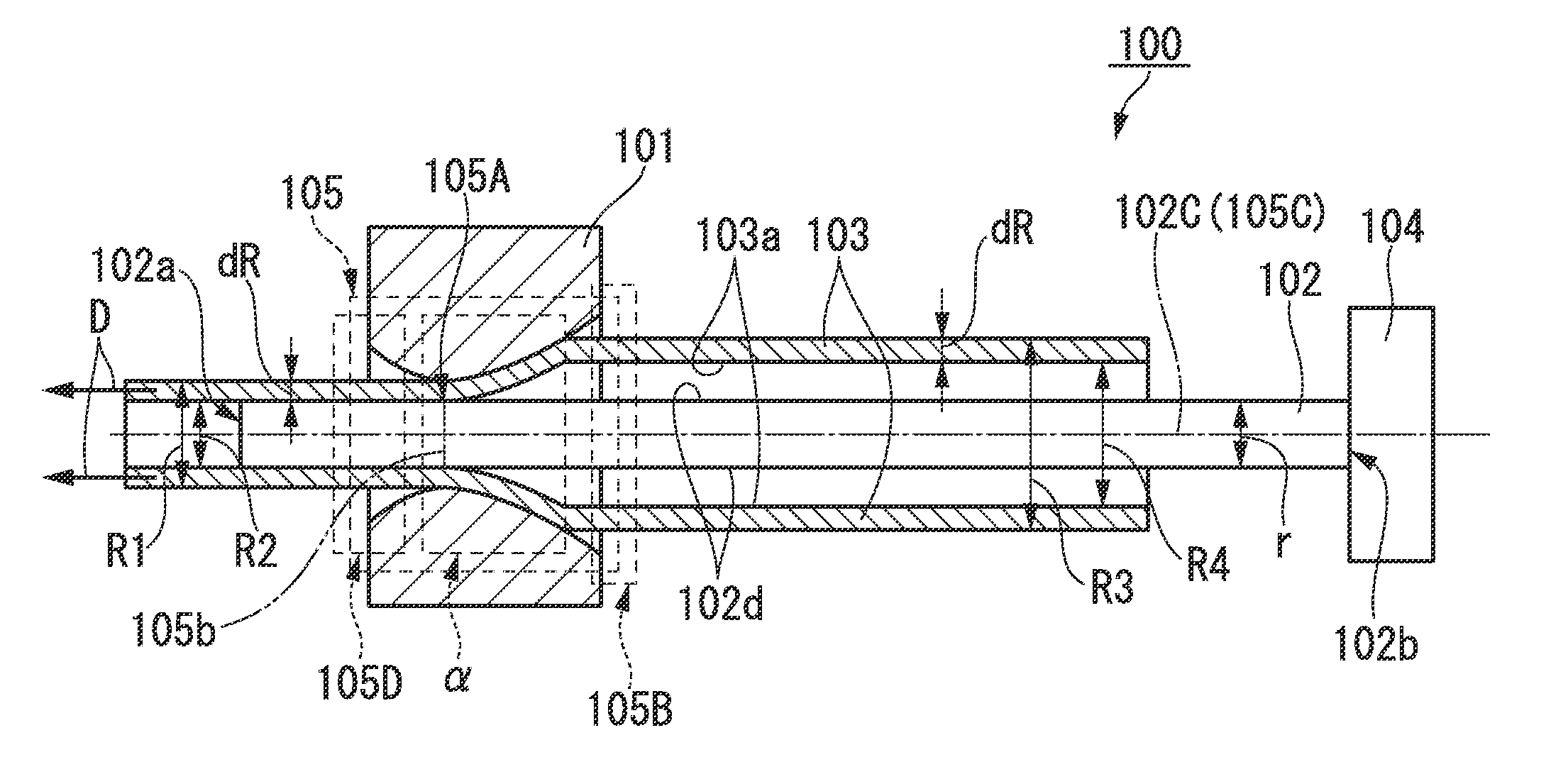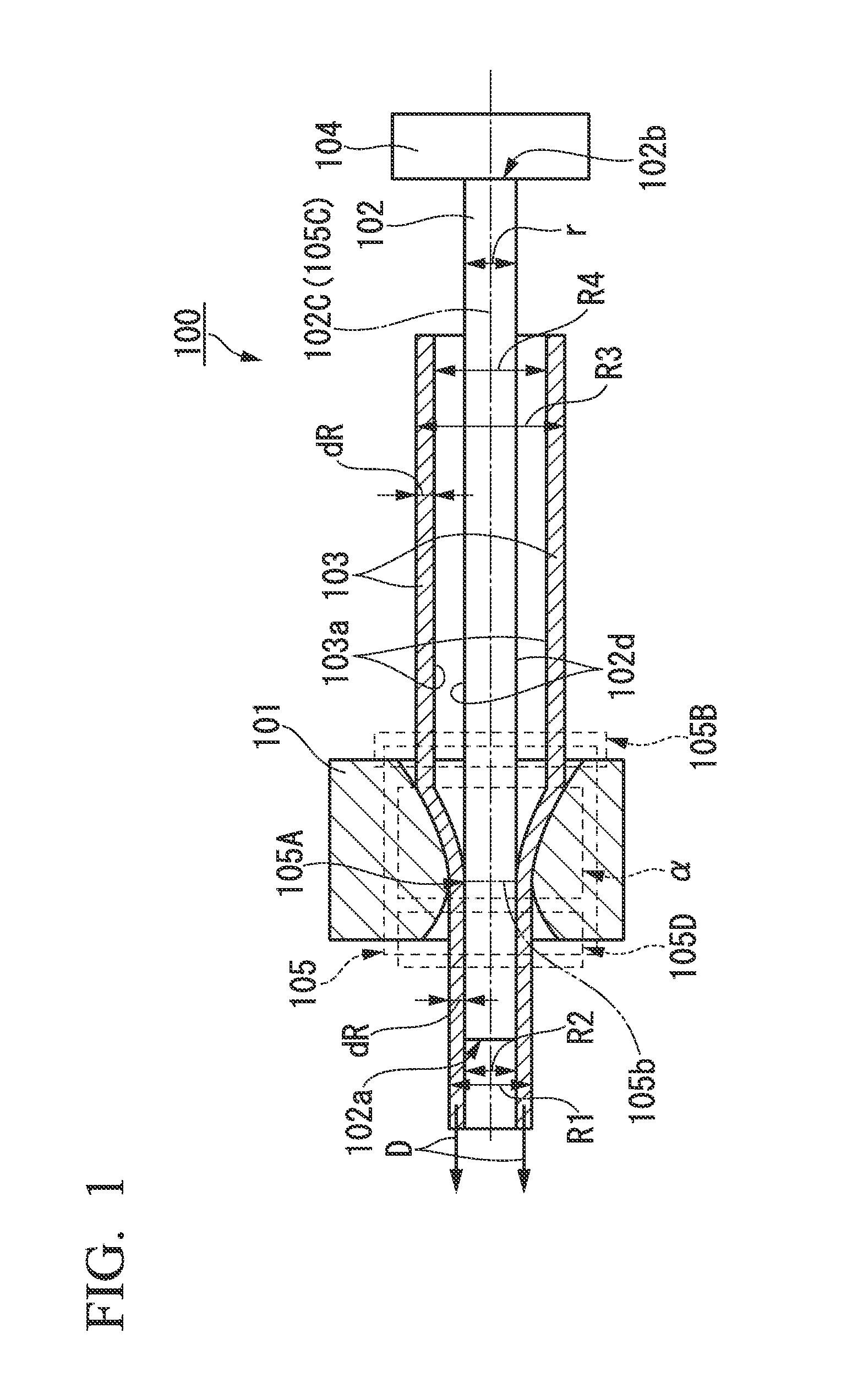Thin, narrow tube and drawing apparatus and drawing method for manufacturing the same
- Summary
- Abstract
- Description
- Claims
- Application Information
AI Technical Summary
Benefits of technology
Problems solved by technology
Method used
Image
Examples
first embodiment
Drawing Apparatus
[0075]The configuration of a drawing apparatus of the present invention will be described. The drawing apparatus of the present invention includes at least first means, second means, and a fixing tool of the second means. The first means includes a part α which surrounds a round tube while being in contact therewith in a circumferential direction to reduce the diameter thereof. The second means has a cylindrical shape and is disposed to oppose a minimum inner diameter portion of the part α of the first means so that the side surface thereof supports the inner wall surface of the round tube.
[0076]In the above-described configuration of the drawing apparatus, an example of a case in which a die is used as the first means 101 and a mandrel is used as the second means 102 will be described with reference to FIG. 1. FIG. 1 is a cross-sectional view of a drawing apparatus 100 taken along a plane parallel to a drawing direction D of the round tube 103 to be processed. The ...
example 1
[0112]The Example 1 of the above-described drawing apparatus will be described. A crucible made of graphite for high-frequency induction heating, which accommodates a mixture of pure magnesium metal (350 [g]) and pure calcium metal (2.8 [g]) was placed inside a high-frequency coil in a high-frequency melting furnace chamber. Next, the inside of the chamber was evacuated, and then was filled with helium gas to atmospheric pressure. Subsequently, the crucible was heated to 750 [° C.] and then was held for 10 minutes after checking that the accommodated mixture was melted. Thereafter, the mixture (molten alloy) which was melted in the crucible was poured into a cylindrical type mold which was placed on the front surface of the high-frequency coil in advance. In addition, after cooling the resultant for a certain time, a cylindrical alloy ingot was obtained from the mold.
[0113]Next, the obtained alloy ingot was processed into a bar having an outer diameter of 17 [mm] through hot extrusi...
example 2
[0115]The Example 2 of the above-described drawing apparatus will be described. A crucible made of graphite for high-frequency induction heating which accommodates a mixture of pure magnesium metal (350 [g]) and pure calcium metal (2.8 [g]) was placed inside a high-frequency coil in a high-frequency melting furnace chamber. Next, the inside of the chamber was evacuated, and then was filled with helium gas to atmospheric pressure. Subsequently, the crucible was heated to 750[° C.] and then was held for 10 minutes after checking that the accommodated mixture was melted. Thereafter, the mixture (molten alloy) which was melted in the crucible was poured into a cylindrical type mold which was placed on the front surface of the high-frequency coil in advance.
[0116]In addition, after cooling the resultant for a certain time, a cylindrical alloy ingot was obtained from the mold.
[0117]Next, the obtained alloy ingot was processed into a bar having an outer diameter of 17 [mm] through hot extr...
PUM
| Property | Measurement | Unit |
|---|---|---|
| Fraction | aaaaa | aaaaa |
| Fraction | aaaaa | aaaaa |
| Angle | aaaaa | aaaaa |
Abstract
Description
Claims
Application Information
 Login to View More
Login to View More - R&D Engineer
- R&D Manager
- IP Professional
- Industry Leading Data Capabilities
- Powerful AI technology
- Patent DNA Extraction
Browse by: Latest US Patents, China's latest patents, Technical Efficacy Thesaurus, Application Domain, Technology Topic, Popular Technical Reports.
© 2024 PatSnap. All rights reserved.Legal|Privacy policy|Modern Slavery Act Transparency Statement|Sitemap|About US| Contact US: help@patsnap.com










